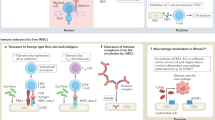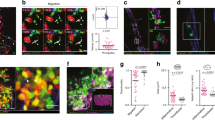Abstract
It is widely believed that rolling lymphocytes require successive chemokine-induced signaling for lymphocyte function–associated antigen 1 (LFA-1) to achieve a threshold avidity that will mediate lymphocyte arrest. Using an in vivo model of lymphocyte arrest, we show here that LFA-1-mediated arrest of lymphocytes rolling on high endothelial venules bearing LFA-1 ligands and chemokines was abrupt. In vitro flow chamber models showed that endothelium-presented but not soluble chemokines triggered instantaneous extension of bent LFA-1 in the absence of LFA-1 ligand engagement. To support lymphocyte adhesion, this extended LFA-1 conformation required immediate activation by its ligand, intercellular adhesion molecule 1. These data show that chemokine-triggered lymphocyte adhesiveness involves a previously unrecognized extension step that primes LFA-1 for ligand binding and firm adhesion.
This is a preview of subscription content, access via your institution
Access options
Subscribe to this journal
Receive 12 print issues and online access
$209.00 per year
only $17.42 per issue
Buy this article
- Purchase on Springer Link
- Instant access to full article PDF
Prices may be subject to local taxes which are calculated during checkout








Similar content being viewed by others
References
Warnock, R.A., Askari, S., Butcher, E.C. & von Andrian, U.H. Molecular mechanisms of lymphocyte homing to peripheral lymph nodes. J. Exp. Med. 187, 205–216 (1998).
Shimaoka, M., Takagi, J. & Springer, T.A. Conformational regulation of integrin structure and function. Annu. Rev. Biophys. Biomol. Struct. 31, 485–516 (2002).
Carman, C.V. & Springer, T.A. Integrin avidity regulation: are changes in affinity and conformation underemphasized? Curr. Opin. Cell Biol. 15, 547–556 (2003).
Salas, A. et al. Rolling adhesion through an extended conformation of integrin αLβ2 and relation to αI and βI-like domain interaction. Immunity 20, 393–406 (2004).
Constantin, G. et al. Chemokines trigger immediate β2 integrin affinity and mobility changes: differential regulation and roles in lymphocyte arrest under flow. Immunity 13, 759–769 (2000).
Stein, J.V. et al. The CC chemokine thymus-derived chemotactic agent 4 (TCA-4, secondary lymphoid tissue chemokine, 6Ckine, Exodus-2) triggers lymphocyte function-associated antigen 1-mediated arrest of rolling T lymphocytes in peripheral lymph node high endothelial venules. J. Exp. Med. 191, 61–76 (2000).
Campbell, J.J., Hedrick, J., Zlotnik, A., Siani, M.A. & Thompson, D.A. Chemokines and the arrest of lymphocytes rolling under flow conditions. Science 279, 381–384 (1998).
Sasaki, K., Okouchi, Y., Rothkotter, H.J. & Pabst, R. Ultrastructural localization of the intercellular adhesion molecule (ICAM-1) on the cell surface of high endothelial venules in lymph nodes. Anat. Rec. 244, 105–111 (1996).
Beals, C.R., Edwards, A.C., Gottschalk, R.J., Kuijpers, T.W. & Staunton, D.E. CD18 activation epitopes induced by leukocyte activation. J. Immunol. 167, 6113–6122 (2001).
Lum, A.F., Green, C.E., Lee, G.R., Staunton, D.E. & Simon, S.I. Dynamic regulation of LFA-1 activation and neutrophil arrest on intercellular adhesion molecule 1 (ICAM-1) in shear flow. J. Biol. Chem. 277, 20660–20670 (2002).
Beglova, N., Blacklow, S.C., Takagi, J. & Springer, T.A. Cysteine-rich module structure reveals a fulcrum for integrin rearrangement upon activation. Nat. Struct. Biol. 9, 282–287 (2002).
Xie, C. et al. The integrin α-subunit leg extends at a Ca2+-dependent epitope in the thigh/genu interface upon activation. Proc. Natl. Acad. Sci. USA 101, 15422–15427 (2004).
Kucik, D.F., Dustin, M.L., Miller, J.M. & Brown, E.J. Adhesion-activating phorbol ester increases the mobility of leukocyte integrin LFA-1 in cultured lymphocytes. J. Clin. Invest. 97, 2139–2144 (1996).
Lub, M., van Kooyk, Y., van Vliet, S.J. & Figdor, C.G. Dual role of the actin cytoskeleton in regulating cell adhesion mediated by the integrin lymphocyte function-associated molecule-1. Mol. Biol. Cell 8, 341–351 (1997).
Kim, M., Carman, C.V., Yang, W., Salas, A. & Springer, T.A. The primacy of affinity over clustering in regulation of adhesiveness of the integrin αLβ2 . J. Cell Biol. 167, 1241–1253 (2004).
Alon, R. & Feigelson, S. From rolling to arrest on blood vessels: leukocyte tap dancing on endothelial integrin ligands and chemokines at sub-second contacts. Semin. Immunol. 14, 93–104 (2002).
Zhang, N., Hodge, D., Rogers, T.J. & Oppenheim, J.J. Ca2+-independent protein kinase Cs mediate heterologous desensitization of leukocyte chemokine receptors by opioid receptors. J. Biol. Chem. 278, 12729–12736 (2003).
Shimaoka, M. et al. Structures of the αL I domain and its complex with ICAM-1 reveal a shape-shifting pathway for integrin regulation. Cell 112, 99–111 (2003).
Huth, J.R. et al. NMR and mutagenesis evidence for an I domain allosteric site that regulates lymphocyte function-associated antigen 1 ligand binding. Proc. Natl. Acad. Sci. USA 97, 5231–5236 (2000).
Kim, M., Carman, C.V. & Springer, T.A. Bidirectional transmembrane signaling by cytoplasmic domain separation in integrins. Science 301, 1720–1725 (2003).
Tadokoro, S. et al. Talin binding to integrin β tails: a final common step in integrin activation. Science 302, 103–106 (2003).
Monkley, S.J., Pritchard, C.A. & Critchley, D.R. Analysis of the mammalian talin2 gene TLN2. Biochem. Biophys. Res. Commun. 286, 880–885 (2001).
Jung, U., Norman, K.E., Scharffetter-Kochanek, K., Beaudet, A.L. & Ley, K. Transit time of leukocytes rolling through venules controls cytokine-induced inflammatory cell recruitment in vivo. J. Clin. Invest. 102, 1526–1533 (1998).
Ley, K., Allietta, M., Bullard, D.C. & Morgan, S. The importance of E-selectin for firm leukocyte adhesion in vivo. Circ. Res. 83, 287–294 (1998).
Dustin, M.L., Bivona, T.G. & Philips, M.R. Membranes as messengers in T cell adhesion signaling. Nat. Immunol. 5, 363–372 (2004).
Grabovsky, V., Dwir, O. & Alon, R. Endothelial chemokines destabilize L-selectin-mediated lymphocyte rolling without inducing selectin shedding. J. Biol. Chem. 277, 20640–20650 (2002).
Shamri, R. et al. Chemokine-stimulation of lymphocyte α4 integrin avidity but not of LFA-1 avidity to endothelial ligands under shear flow requires cholesterol membrane rafts. J. Biol. Chem. 277, 40027–40035 (2002).
Finger, E.B., Bruehl, R.E., Bainton, D.F. & Springer, T.A. A differential role for cell shape in neutrophil tethering and rolling on endothelial selectins under flow. J. Immunol. 157, 5085–5096 (1996).
Abitorabi, M.A., Pachynski, R.K., Ferrando, R.E., Tidswell, M. & Erle, D.J. Presentation of integrins on leukocyte microvilli: a role for the extracellular domain in determining membrane localization. J. Cell Biol. 139, 563–571 (1997).
Sampath, R., Gallagher, P.J. & Pavalko, F.M. Cytoskeletal interactions with the leukocyte integrin β2 cytoplasmic tail. Activation-dependent regulation of associations with talin and α-actinin. J. Biol. Chem. 273, 33588–33594 (1998).
Yan, B., Calderwood, D.A., Yaspan, B. & Ginsberg, M.H. Calpain cleavage promotes talin binding to the β3 integrin cytoplasmic domain. J. Biol. Chem. 276, 28164–28170 (2001).
Pfaff, M., Liu, S., Erle, D.J. & Ginsberg, M.H. Integrin β cytoplasmic domains differentially bind to cytoskeletal proteins. J. Biol. Chem. 273, 6104–6109 (1998).
Katagiri, K., Maeda, A., Shimonaka, M. & Kinashi, T. RAPL, a Rap1-binding molecule that mediates Rap1-induced adhesion through spatial regulation of LFA-1. Nat. Immunol. 4, 741–748 (2003).
Giagulli, C. et al. RhoA and ζ PKC control distinct modalities of LFA-1 activation by chemokines critical role of LFA-1 affinity triggering in lymphocyte in vivo homing. Immunity 20, 25–35 (2004).
Shimonaka, M. et al. Rap1 translates chemokine signals to integrin activation, cell polarization, and motility across vascular endothelium under flow. J. Cell Biol. 161, 417–427 (2003).
Alon, R. et al. A novel genetic leukocyte adhesion deficiency in subsecond triggering of integrin avidity by endothelial chemokines results in impaired leukocyte arrest on vascular endothelium under shear flow. Blood 101, 4437–4445 (2003).
Kinashi, T. et al. LAD-III, a leukocyte adhesion deficiency syndrome associated with defective Rap1 activation and impaired stabilization of integrin bonds. Blood 103, 1033–1036 (2004).
Lupher, M.L., Jr et al. Cellular activation of leukocyte function-associated antigen-1 and its affinity are regulated at the I domain allosteric site. J. Immunol. 167, 1431–1439 (2001).
Li, R. et al. Activation of integrin αIIβ3 by modulation of transmembrane helix associations. Science 300, 795–798 (2003).
Huang, C. & Springer, T.A. A binding interface on the I domain of lymphocyte function-associated antigen-1 (LFA-1) required for specific interaction with intercellular adhesion molecule 1 (ICAM-1). J. Biol. Chem. 270, 19008–19116 (1995).
Cabanas, C. & Hogg, N. Ligand intercellular adhesion molecule 1 has a necessary role in activation of integrin lymphocyte function-associated molecule 1. Proc. Natl. Acad. Sci. USA 90, 5838–5842 (1993).
van Kooyk, Y. et al. Activation of LFA-1 through a Ca2+-dependent epitope stimulates lymphocyte adhesion. J. Cell Biol. 112, 345–354 (1991).
Grabovsky, V. et al. Subsecond induction of α4 integrin clustering by immobilized chemokines enhances leukocyte capture and rolling under flow prior to firm adhesion to endothelium. J. Exp. Med. 192, 495–505 (2000).
Cinamon, G., Shinder, V. & Alon, R. Shear forces promote lymphocyte migration across vascular endothelium bearing apical chemokines. Nat. Immunol. 2, 515–522 (2001).
Maly, P. et al. The Fuc-TVII α1,3 fucosyltransferase controls leukocyte trafficking through an essential role in L-, E-, and P-selectin ligand biosynthesis. Cell 86, 643–653 (1996).
Gauguet, J.M., Rosen, S.D., Marth, J.D. & Von Andrian, U.H. Core 2 branching β1,6-N-acetylglucosaminyltransferase and high endothelial cell N-acetylglucosamine-6-sulfotransferase exert differential control over B and T lymphocyte homing to peripheral lymph nodes. Blood 104, 4104–4112 (2004).
Pries, A.R. A versatile video image analysis system for microcirculatory research. Int. J. Microcirc. Clin. Exp. 7, 327–345 (1988).
M'Rini, C. et al. A novel endothelial L-selectin ligand activity in lymph node medulla that is regulated by α1,3-fucosyltransferase-IV. J. Exp. Med. 198, 1301–1312 (2003).
Sigal, A. et al. The LFA-1 integrin supports rolling adhesions on ICAM-1 under physiological shear flow in a permissive cellular environment. J. Immunol. 165, 442–452 (2000).
Acknowledgements
We thank S. Schwarzbaum for editorial help. Supported by the German-Israeli Foundation for Scientific Research and Development, the Israel Science Foundation and MAIN, the EU6 Program for Migration and Inflammation.
Author information
Authors and Affiliations
Corresponding author
Ethics declarations
Competing interests
The authors declare no competing financial interests.
Supplementary information
Supplementary Fig. 1
Instantaneous rolling velocities of 11 lymphocytes (cells a-k). (PDF 377 kb)
Supplementary Fig. 2
Immobilized but not soluble SDF-1 triggers instantaneous LFA-1 activation on lymphocytes tethered to and rolling on an inflamed endothelial surface. (PDF 106 kb)
Rights and permissions
About this article
Cite this article
Shamri, R., Grabovsky, V., Gauguet, JM. et al. Lymphocyte arrest requires instantaneous induction of an extended LFA-1 conformation mediated by endothelium-bound chemokines. Nat Immunol 6, 497–506 (2005). https://doi.org/10.1038/ni1194
Received:
Accepted:
Published:
Issue Date:
DOI: https://doi.org/10.1038/ni1194
This article is cited by
-
Nectins and Nectin-like molecules drive vascular development and barrier function
Angiogenesis (2023)
-
The immune synapses reveal aberrant functions of CD8 T cells during chronic HIV infection
Nature Communications (2022)
-
Leukaemia: a model metastatic disease
Nature Reviews Cancer (2021)
-
Leukocyte trafficking to the lungs and beyond: lessons from influenza for COVID-19
Nature Reviews Immunology (2021)
-
LFA-1 cluster formation in T-cells depends on l-plastin phosphorylation regulated by P90RSK and PP2A
Cellular and Molecular Life Sciences (2021)



